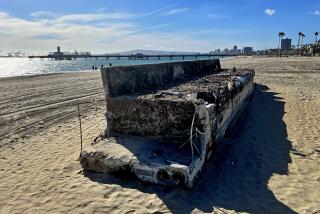Grubbing Up the Beaches: ‘It’s Labor, Labor, Labor’
- Share via
HUNTINGTON BEACH — After days of back-breaking work along oil-stained Orange County beaches, Mark Smith began to show signs of wear Tuesday.
“It’s labor, labor, labor,” said Smith, 27, a Compton resident hired to swab the sand with cloth squares. “I’ve never worked this hard.”
About 700 workers were added to the cleanup effort Tuesday, bringing the total to about 1,100. Another 450 to 500 are expected to be working after training today, according to officials at Southwest VECO Inc. in Long Beach, one of the firms contracted to do the cleanup.
For the work crews, Tuesday was another tough day, one that some described as the worst they have seen yet, with oil several inches thick washing ashore.
Crews were scattered along major hot spots, mainly north of the Huntington Beach Municipal Pier to Bolsa Chica State Beach, where waves of black and brown crude continued to roll in along pockets of the beach.
“This is the worst here,” said Smith, who has been working on the spill cleanup for three days. “You can smell it. I’m just hoping it doesn’t kill me.”
About every 100 yards, the beach was littered with piles of trash bags, most of them full of used, oily rags and yellow slickers. The trash has been taken to a seven-acre site next to the Newport Sewage Treatment Plant, where federal Environmental Protection Agency officials will begin studies to determine where to dispose of it, said Tony Kozlowski, a British Petroleum spokesman.
The crews still struggled to stay abreast of the oil washing in with the surf, centering themselves where major clumps of oil flowed in on waves.
“It’s tearing up our uniforms, it’s so heavy,” one worker combing the sand north of the pier said of the oil.
Along the shore, joggers, residents, bike riders and other spectators lined the area just north of the intersection of 17th Street and Pacific Coast Highway, watching the workers clean up. Some of the onlookers said Huntington Beach residents could do a better and quicker job if restrictions were lifted.
“I think if they got more of the public involved, they’d see more action,” said Roger Peterson, 34, a surfboard manufacturer in Huntington Beach.
Many workers said that they had never worked on an oil spill and that the cleanup has at times been frustrating.
“It’s on the ground and it’s pretty thick,” said Glen Latham, 25, wearing yellow slickers, a hard hat, goggles and a breathing mask because of the fumes. “The water looks like it’s getting worse and worse.
“It seems like you clean up a spot and the water will push it over and over again,” he said.
According to the U.S. Coast Guard, about 80% of the nearly 400,000 gallons of oil that leaked out of the tanker American Trader has been mopped up or skimmed from the sea, or has evaporated.
Tom Perea, 22, of Lakewood, who also was combing the stretch of beach north of the Huntington Beach Pier, had taped both his wrists and ankles with silver duct tape. He said he was told to do that to safeguard against getting benzene, a toxin that sometimes is found in oil, on his skin.
Still, Perea said the danger did not worry him.
“Even if they weren’t paying, we would come out just to clean up,” he said. “We’ve cleaned up a lot.”
Federal Occupational Safety and Health Administration officials, based in a trailer near the city lifeguard headquarters at Pacific Coast Highway and Lake Street, were wandering among the crews, worried that some workers may have been rushed to the beach without adequate training.
“We’re finding that in a lot of the cases they’re not getting that much (training),” said Tino R. Serrano, assistant regional director for the U.S. Department of Labor.
Serrano said OSHA has been working with contractors, trying to keep people without a lot of training out of the most dangerous areas.
Before they can start cleaning up, workers must undergo a 24-hour training session that includes instructions on cleanup, first aid and safety. But the long training hasn’t kept potential workers away.
“It puts beans on the table,” one VECO supervisor who didn’t want his name used said of the work. “A lot of people here have never had a job this good.”
By Thursday, 300 members of the California Conservation Corps will have been dispatched to the beaches to help in the cleanup. The CCC is contracted to assist in disasters such as spills and floods and in environmental maintenance. Its members, all 18-to-23-year-olds, are paid minimum wage, but they also work for the educational experience, said Walt Auburn, a spokesman for the agency.
In Long Beach, about 300 people lined up at a Southwest VECO office to get jobs, which start at $10 an hour. Some had been there since 11 p.m. Monday. The firm is no longer taking applications, company officials said.
Times staff writers Stephen C. Chavez and Danica Kirka contributed to this report.
More to Read
Sign up for Essential California
The most important California stories and recommendations in your inbox every morning.
You may occasionally receive promotional content from the Los Angeles Times.













